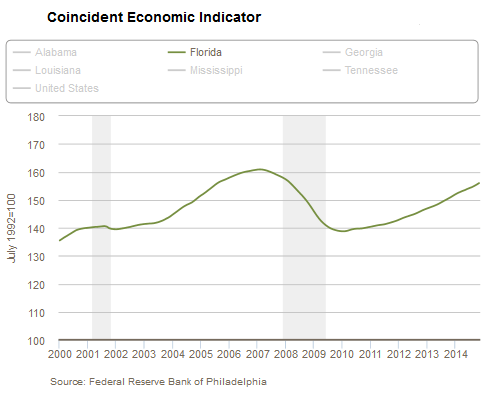During the last several months, business contacts in south Florida have been reporting improving economic conditions. They've discussed increased opportunities for capital expenditure projects, optimistic hiring plans, and a general upturn in business activity. This optimism made me wonder if the data on Florida's economic activity reflected what we've been hearing from our contacts in south Florida.
In November, coincident economic indicator, which measures overall economic activity, was 155.99 (see the chart). The index has been steadily improving since 2012. Although it has not yet reached its peak of 160.87 from February 2007, it seems to be within reach. While the November data for metro areas are not yet available, our South Florida business contacts recently indicated that the economy in south Florida continues to improve. Falling oil prices have not had a direct impact on businesses yet, though the general consensus is that oil's price decline is good for the consumer and consumer spending should improve if these lower prices are sustained.

On the manufacturing front, the Southeast Purchasing Managers Index, which is produced by the Econometric Center at Kennesaw State University and measures regional manufacturing activity, declined to 54.1 in November (see the chart). However, with the exception of this past September, it has remained in expansionary territory since August 2012. (A reading above 50 indicates expansion in overall activity; a reading below 50 indicates a decline.)

Regarding employment, payroll employment in Florida hit its trough in March 2007 and has been steadily increasing since then. In November, payroll employment in the state increased by 41,900 to 7.897 million employed, remaining slightly below the prerecession peak of 8.053 million (see the chart). South Florida business contacts, however, specifically report continued challenges in filling positions with specialized skills in technology, mathematics, engineering, management, and lending.

While Florida's unemployment rate has a ways to go before reaching its prerecession low of 3.3 percent, it improved steadily from April 2012 through December 2013 and then plateaued at a little more than 6 percent for the first eight months of 2014 (see the chart). A downward trend in unemployment started in August of last year, reaching 5.8 percent in November. Anecdotally, we heard positive reports from contacts in the employment sector of an uptick in activity from employers using employment agencies to fill open positions.

As you can see from the data above, overall economic activity continues to look promising in Florida, supporting the information we've been receiving from business contacts. Let's hope conditions remain accommodative and that our contacts continue to report good news.
By Marycela Diaz-Unzalu, a senior Regional Economic Information Network analyst at the Atlanta Fed's Miami Branch



